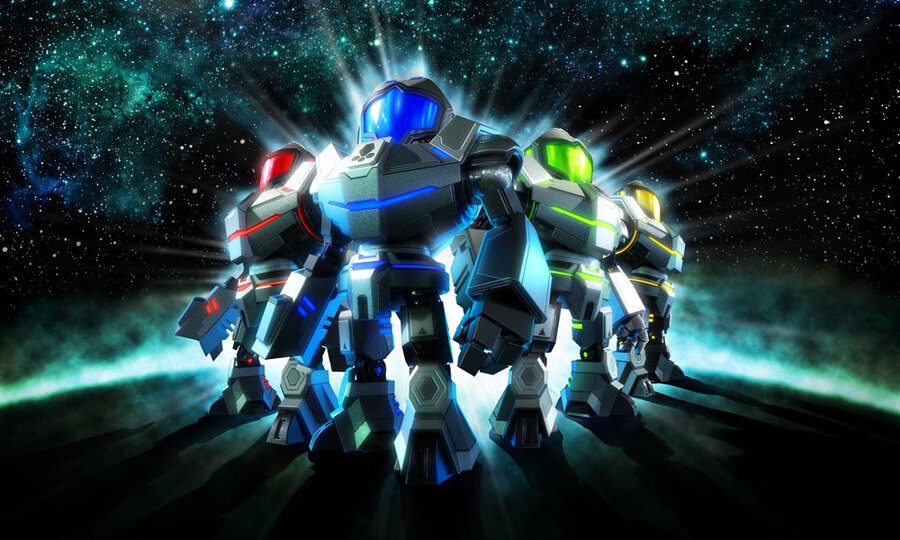
It's safe to say the general - or at least loudest - response from Metroid fans upon the reveal of Metroid Prime: Federation Force was one of disappointment. One year on and things have calmed down a little bit, but is there enough in this game to sway those who spoke so strongly against it at E3 2015?
First and foremost we're dealing with a co-op game here; the whole experience is built around the idea of four players playing together locally or over the internet all at once, but thankfully the execution is far less intrusive than in similar titles such as The Legend of Zelda: Tri Force Heroes. Whilst every level is designed for co-op there's no instance of multiple players being required to perform a simultaneous action beyond opening a door or finishing a level; as such each mission you traverse is entirely enjoyable as a solo experience as well as a multiplayer one. We wanted to nip that in the bud right away.
Subscribe to Nintendo Life on YouTube841k
Everything feels very similar to the original Metroid Prime games; even the controls bear a striking resemblance to those of the first two titles on the GameCube. If you're boasting a New 3DS, its XL counterpart or a Circle Pad Pro you can change the controls to more closely resemble twin-stick controls, which is what this writer personally preferred in our play time with the latest build. The New 3DS console's C-Stick isn't as accurate as many would like, but thankfully as with all previous titles in the series you can use the lock-on function to better help keep track of things. The performance and frame rate were also top-notch in our time playing, which is extremely impressive given the limited hardware.
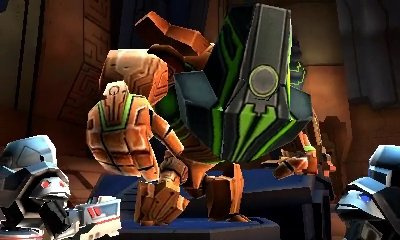
The missions are surprisingly varied, and once you've hopped into your big mech the early levels focus more heavily on showing you the ropes, with fewer enemies and more puzzle-based challenges. These revolve around firing orbs around a level into their appropriate holes in a similar fashion to Metroid Prime: Blast Ball, which we'll get onto in a moment. Another mission we played tasked us with herding giant ice monsters into similarly giant cages, since their armour was too thick to destroy with conventional weaponry.
A little worried that the core combat of the series had been sidelined, we were relieved when a later level consisted of just as much Space Pirate blasting as we'd hoped for. The difficulty of the game doesn't change depending on how many players you have either, so if you're planning to go through this thing solo you'd better bring your A-game.
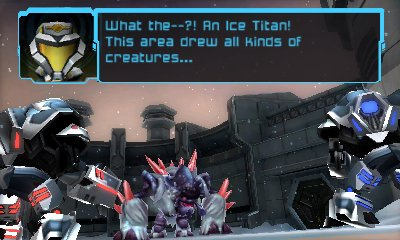
Various secondary weapons and features can help bring you and your potential teammates through as well, such as health capsules you drop onto the ground, powerful ice and fire blasts, a beam that slows an enemy to an eventual stop for a short time, and even a decoy for enemies to hassle that bears a striking resemblance to the Varia Suit-wearing bounty hunter we all know and love. You select these additional powers before you start the game in a style not unlike the Monster Hunter series, and as you'd expect you can only carry so much with different items taking up different amounts of space.
Further to this you can also customise your mech with mods to give you an edge and change the way you play. Everything from additional defence or attack to gaining health if you use a health item on a teammate rather than yourself. These mods are scattered all over the missions but not only can you only equip a few at a time before the mission begins, but if you're taken down by an enemy these mods can break permanently, rendering them useless. It's a great way to give more incentive to staying alive, as a downed teammate need only be revived by another player to get back into the game, and it's only game over if everyone is downed at the same time (adding yet another layer of difficulty to the single player).
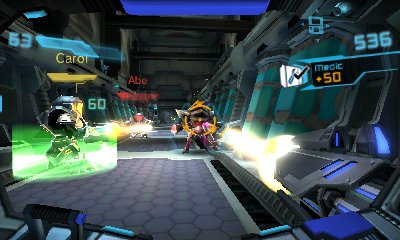
So the missions we've played are strong, challenging, have a good level of polish, run very well on the New 3DS, and can be enjoyed just as well in single player (albeit with a higher level of difficulty). But what about the sporty side of this 3DS endeavour known only as Blast Ball? Well if you've seen it before you'll already know what it is. You and two teammates take on another team of three with the aim being to shoot a giant glowing ball into the opponents' goal, like a game of football in Peckham (a part of London, for you non-Brits).
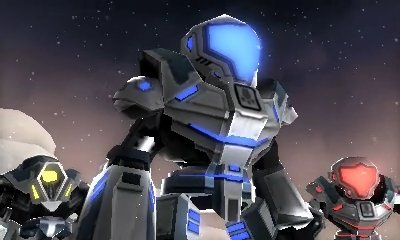
Despite its incredibly simple premise, the design and execution of Blast Ball is absolutely excellent. You can take on a team of bots to unlock rewards, or go toe-to-toe with another team of real people locally or online. You're also not going to be able to rely solely on getting the ball to its intended destination either, as just like the main game you have a health bar that can be depleted, requiring you to wait for a few seconds before respawning. As you appropriately blast the ball powerups will be spewed out for either team to grab, allowing the user to gain an impenetrable shield, a speed boost, or even force the other team to all be ejected from their mechs at once, forcing them to run back in before they can get back into play. Everything about this mode screams Next Level Games, and whilst it may not have much appeal in solo play if you like intense, exhilarating multiplayer madness, Blast Ball has you signed, sealed, and delivered.
Metroid Prime: Federation Force is shaping up to be an excellent little addition to the series. It's not Metroid Prime 4, but it's not trying to be either. It takes the series' formula and places it into a much more suitable style for the system it's on rather than trying to make the 3DS handle a full Metroid Prime experience. If the rest of the missions are as good as the ones we've played, we could well be onto a winner.





Comments 81
I'm actually quite hyped for this, it looks like an absolute blast.
it looks fun I'll get it but I still would have preferred a real 2D Metroid. imagine Super Metroid with 3DS graphics. even a remake of the first Metroid would have been awesome.
@Tsurii I sadly have to agree with TFH. Love the feel of the game. Hate the forced co-op.
I had this down for pre-order since day one and I'm no Metroid fan. This looks like a great start for me in the Metroid franchise
@BensonUii Huh, the rumours were right after all. It was this week
It was a surprise, did not expect to see demo soon.
Still dont care for this. Sue me.
@BensonUii That Blast Ball was going to be released this week. One of my mates told me about it. Guess he was right after all.
So it's basically Monster Hunter in a stylized version of the Metroid universe. When I start to get tired of Monster Hunter, I may have to take a dive into this one.
Still wish they had done it in the style/framework of Metroid Prime: Hunters. That was a great multiplayer-focused spinoff that deserves to be revisited.
I must say this game looks like it could be a pleasant unexpected surprise. Even thought I am no Metroid fan I may pick this up to show my support. Also online support for Blast Ball is also a plus
Still wish Metroid 30th anniversary would of got soemthign else than a spin-off.
I want a 2.5D sidescrolling Metroid. The last sidescrolling game was on GBA with Zero Mission, since then they kept releasing Prime stuff.
@BensonUii He says it will be following BotW's release date logic and will be released in 2020
I've been looking forward to this title actually can't wait .
This game looks pretty decent despite all the negativity when it was first announced, of course, I won't be able to get it because no handheld, but oh well.
I'm surprised! The negative reaction must be because of bad marketing rather than being a bad game.
I expect it to be a good game worth playing. I do not expect it to be a metroid game though. Just in the metroid universe. Capt toad was a good game despite not being Mario. I trust Nintendo. I can't wait for this. I still enjoy triforce hereos. It just isn't fun single player.
Thank you for the preview, I have been wanting more clarity on what this game is about. It's great there will be a demo of blastball as well!
Nintendo: stay the same and we hate you. Change and we hate you.
"Whilst every level is designed for co-op there's no instance of multiple players being required to perform a simultaneous action beyond opening a door or finishing a level; as such each mission you traverse is entirely enjoyable as a solo experience as well as a multiplayer one. We wanted to nip that in the bud right away."
Boom. That's exactly what I wanted to hear!!!!! I will likely play mostly solo, but occasionally sprinkle some multiplayer in there...I honestly, think this will be a good game. Not a great one, but a much better game than what was seen and reacted to last year.
But why did they have to make the characters stupid frikin' chibi designs!
That's honestly the biggest gripe I have with this game.
Sounds like a pretty fun game, I'll probably pick it up later in the year since I'm still saving up some money for Monster Hunter Generations.
PSA: I went hands on with this game recently too. It's not....bad!
I don't quite get the reference to Peckham. Is the implication that it's a dystopian, science fiction waste land?
I'm hoping this at least inspires a couple devs to bring some FPS to 3DS before the end of its lifespan. I don't need good graphics, even something along the lines of the old Wolfenstein 3D would work.
The chibi style rubs me the wrong way, but this preview has 80% sold me. From the sound of it, I think this game is gonna get 8's. If it does, I'll do it.
Being a huge metroid fan, im going to give this a try and Prime FF. I can see why Nintendo has made the game and Im going to support them because Metroid as a series really need to evolve. Im surprised Nintendo didnt drop the franchise long time ago as most of the titles barely breaks the 1mil point outside the first game and the first Prime.
In the end Nintendo needs to make profits and if Metroid was handled by any other Publisher, the series wouldve been dead long time ago. This franchise needs to evolve much like Fire Emblem did but Nintendo has been doing it wrong, that's all. Instead of going with the chibi graphics, they shouldve atleast made it look more like Ironfall for the 3DS where the graphics are more realistic.
Although I would think Prime FF wouldve been better if they just tried to copy Monster Hunter's gameplay instead and play as Space Pirates to fight big monsters and use their hides and skins to make armor instead of the Kingdom Heart's 3/something days like system with limited resource
Controls are a bit to get used to considering its on a handheld, but user fun. Excited for the final product.
This looks like the first metroid game in the last 20 years I won't buy.
Sounds like the same impression I got from E3 when I watchd Treehouse play it. Cool. Not sure I'm going to buy a bunch of 3DS to play at this point, though. :/
Actually Blast Ball can either be fun or terrible depending on your skill level, and of course since I'm not all that great in Splatoon I haven't won any matches in this either.
The main game looks promising enough though, if only to tide us over for MP4, and at least the co-op elements aren't too enforced...
Not my kind of thing, and I'm still sour from THAT e3. I'm happy it's shaping up to be good, though.
@Snow-Dust I think the reason for the deformed characters in his game is due to technical limitations, not style choice. If they were more realistic it would have taken up a lot more cartridge or memory space.
@therealgamer You know what a Catch 22 is right? It happens.
I don't care if it is a good game in its own right, the main issue I have with this game is that it's not an exploration game, and that's something that's sorely lacking in Nintendo's 8th gen lineup (there's very little outside of Zelda and Xenoblade). That's what we needed a main series Metroid game for. If they've found a way to incorporate both exploration and co-op, then great, but short of that this is a game that could potentially overshadow an IP that is desperately needed in Nintendo's lineup.
It has been surprising that out of the 3 impressions I've read all said the final product is a good or possibly even great game.
@MamaLuigi I dont think so, a lot of 3DS games have proven with more realistic graphics and it works, Prime Hunters were realistic and it worked. It mostly depends on the texture res and the polygonal count but if they kept the res around the same then there shouldnt be too much problem as most polygon count are usually on the head, followed up by the hands (those fingers) but they are wearing helmets so definitely not much will be taken from that department.
I think it's just Nintendo being lazy or cheap and dont want to invest too much on making higher poly count geometry (model)
I may give this a go or wait n see.
It releases on my birthday, I guess I'm gonna preorder it now. My only fear is about the forced co-op, but as long as it haves online, it's okay.
Expecting an enjoyable campaign though.
If Samus is an unlockable character (or character skin, if Nintendo wants us to care for the Galactic Federation that much), that alone would ship some more copies.
I can't honestly imagine how anybody can enjoy Blast Ball. It's a terrible bore to me, but to each their own I guess?
I am super excited for this game. It looks like an amazing multiplayer experience.
@AlexSora89 You can use the Samus amiibos to get a Samus paintjob on your armor.
Sooooo.... You're saying its a really good game...
I should have guessed as much- it's Next Level Games. They always deliver.
Never understood the controversy surrounding this game's reveal. It's a co-op first person shooter set in the Metroid Prime universe for the 3DS. Why's it considered blasphemous to create experimental spinoffs of established IPs?
@MarinoKadame Psst!
http://metroid2remake.blogspot.com/
It's a secret to everybody!
People kept swearing there would be a campaign just for single player. I'm glad that misinformation is finally put to rest
For fans who wanted classic Metroidvania style this is a huge disappointment! This is essentially the four swords of metroid universe. Why they couldn't do I prime 3D with Samus is beyond me. I hate the chibi art style even on enemies.
@MrPuzzlez That's a much better anniversary present than Federation Force.
@LFiM
Which is cool and all, but requiring amiibo to use a skin is something that makes more sense in Mario Kart. In Metroid, the series' protagonist should be playable.
Heck, even Kingdom Hearts: 358/2 Days, for all its faults, allowed players to unlock (spoilers... sorta?) Sora as the final secret character and play as him in Mission Mode.
Playing football in space is safer than in Peckham.
the game sounds great, and if it has an enjoyable difficulty this is gonna be a blast! (pun not intended xD)
@MrPuzzlez Cool, I'll support that instead of Federation Force. It figures, modders and freelance/volunteer coders are still doing what Nintendont. Or Nintendoesnt, whatever.
Got to try this a while ago, it's an okay game but I'm definitely not paying full price for it though. Kinda sad Metroid had no game for the Wii U.
@MrPuzzlez Unfortunately, another good project to be closed and crushed in the upcoming weeks.
I wonder why people can't simply complete the game before advertising "I'm making an unofficial remake of this game, but keep in a secret until it's complete".
@Kirk It's explained in the video (mission briefing). They made it this way because the 3DS hardware limitations can't handle detailed assets smoothly, and aiming would become too difficult in a small resolution.
@rushiosan There's always a "great" excuse that some tool will simply accept without question. lol
@Kirk Its not an excuse. Art style being influenced by hardware limitations is not unheard of
@rushiosan Environments were also compressed vertically to fit with the characters proportions which allows for more information to be displayed onscreen
@Turbo857 These are fanbases we are talking about often they are too close minded to accept anything beyond the established conventions
@Wolfgabe Trust me; it's a bullcrap excuse for having bobble-head characters in this particular game.
I hope it bombs. Still looks bad.
@Turbo857 because there hasn't been a real Metroid game in ages. How is that hard to understand? Not all of us are blind fanboys that gobble up every little thing because of name alone.
"which is extremely impressive given the limited hardware"
Not impressive at all considering the game looks godawful visually, even for a 3DS game.
@rushiosan
Except E.X. Troopers looks better than this with more detailed (if tooney) assets, yet also plays better. Of course that game has lock-on, but I wouldn't find any issue aiming if there was an aiming option.
ALSO, there were many FPSes on DS that are more detailed than this game, and ran on a lower resolution screen yet were still very playable.
This is just a poor excuse to cover up the fact that they thought "kawaii" sells games.
@Kirk Well let me ask you have you ever tried developing a co op based shooter for a handheld with 3DS levels specs? If you did you would likely better understand the limitations and hurdles the devs had to deal with
I always thought this game looked awesome. I was way more excited about this than TFH at E3 last year. I trust Next Level Games when they are working with Nintendo. Always fun and intriguing. We can have METROID spin-offs, trust me... it's okay... ; )
Fans complain how long they have gone without a true follow up to Metroid Prime well guess what some franchises have had even worse gaps. Look at Oddworld its been over 10 years since that series last got a new original title not counting re releases and remakes. Better yet look at Half Life cause lord knows when we will get Half Life 3 which likely be only when Valve learns to count to 3 which will likely be another 30 years
@Wolfgabe lol
@LUIGITORNADO You don't have to be a fanboy to give the game a fair chance, but you do have to be one to be so close minded about a franchise having more variety. If the game is good, then the change is worth it. It's not like there won't be another metroid game with classic gameplay just because this one does well, but what could actually happen is the death of the franchise if this one flops as you want so much since Metroid has never been as big as Mario or Zelda in terms of fanbase and success. That's why there hasn't been a game in so many years after Other M.
Super Metroid is my favourite game ever, and Metroid is my favourite Nintendo franchise and while I wouldn't buy anything just because it has "Metroid" on it's title I'm not a fanboy who holds too hard to nostalgia and can't give new ideas an opportunity before discarding them.
@roy130390
" while I wouldn't buy anything just because it has "Metroid" on it's title I'm not a fanboy who holds too hard to nostalgia and can't give new ideas an opportunity before discarding them."
Well said
Buying it Day One. Three copies.
Sooooooo what if I didn't happen to drop $200 on a N3DS and still have an old XL? How are the controls? Do the graphics or framerate suffer? Why am I the only one asking this?!
@The_Dude_Abides You do realize that only half of the Metroid games to date are 2D games, and all ten of them have been good to great games, right?
This sounds like a very good spinoff to tide us over until the next main series entry. It sounds like it will be the Metroid franchise's "Star Fox Adventures," an excellent game that gets panned by a bunch of fans just for shaking up a bunch of the franchise's conventions.
I get why after Prime 2 and 3, the federation troopers had actually developed into such strong characters both look and skill wise, that they'd want to use them for more.
But these dudes in Federation Froce look almost nothing like Andrew Jones' iconic designs.
The visuals are generally on point and impressive though, so if the game checks out, I guess that's cool.
I wonder how it will play on old hardware. I have no intention to buy a New 3DS at this late point.
I was a little skeptical on this game until I got the demo this morning for blast ball! Simple and tuff all at the same time. Very amusing and addicting. First day but for me, love the co-op missions. Adds a different level of fun! Nintendo should have more games like this!! Pray for the NX!!
@The_Dude_Abides That's debatable. The Metroid Prime Trilogy are among the most beloved Metroid games, and while Other M has its issues, its gameplay is not one of them
You mention playing this on a New 3DS. I only have the original 3DS from launch; will this still work on that?
@stinky_t O3DS controls are far better than N3DS in my opinion. I'm a N3DS owner and I prefer using the gyro. C-Stick is so imprecise for aiming as always. Anyway, it supports CPP, so you'll be fine either way.
@LUIGITORNADO
Well, if I remember correctly the Wii received Other M, Prime 3, and Prime Trilogy and in my assessment that equates to I dunno... a lotta Metroid love for that generation (by extension, that's a lotta love for a franchise by any generational standard). Granted, Wii U hasn't seen much Metroid love outside of Metroid Blast but the reveal of a multiplayer centric portable offering set in the Metroid universe somehow just doesn't motivate me to throw a tantrum or denounce this game's existence.
Yeah, maybe I won't buy it... maybe I will. Yeah, the characters are chibi but honestly, I'm less concerned with character proportions on a screen size as small as a 3DS XL. If it was a home console Metroid I'd have a bigger problem with the character design but I could care less on a 3DS.
Just because Ninty releases a Metroid game for the 3DS doesn't mean they don't have one in the works for your TV. I swear, some Nintendo fans are some of the worst video game fans ever.
Still waiting for review scores, but it sounds like the game is good as a solo experience so I will most likely get it sometime this fall.
@rushiosan Yes, but how is the actual performance, especially during the more hectic gameplay segments and open areas?
Show Comments
Leave A Comment
Hold on there, you need to login to post a comment...